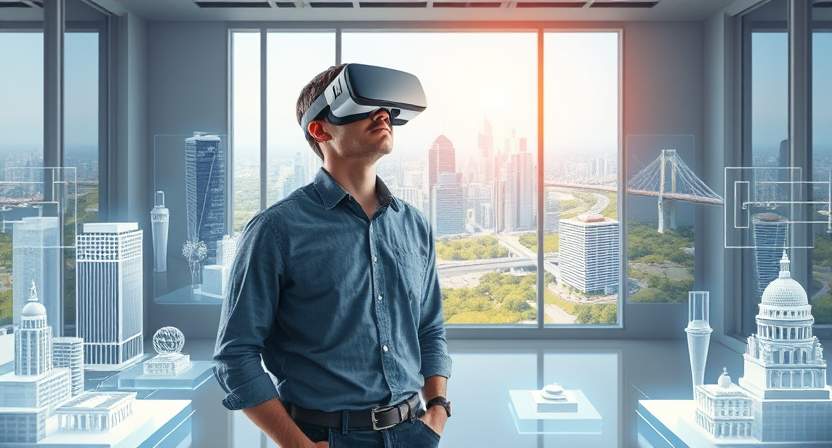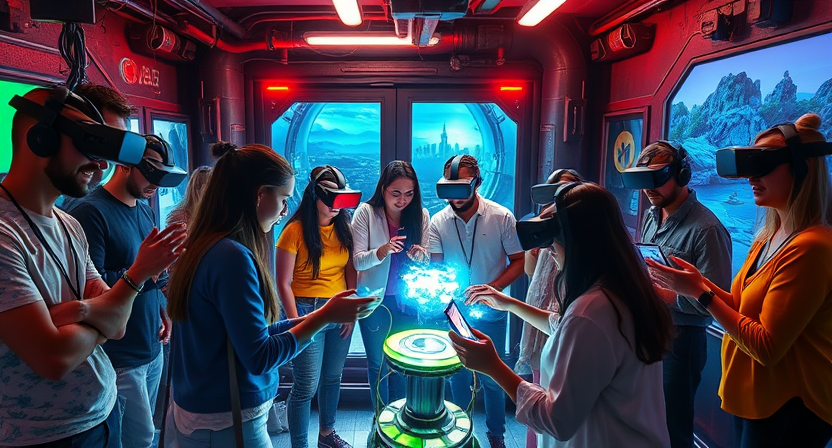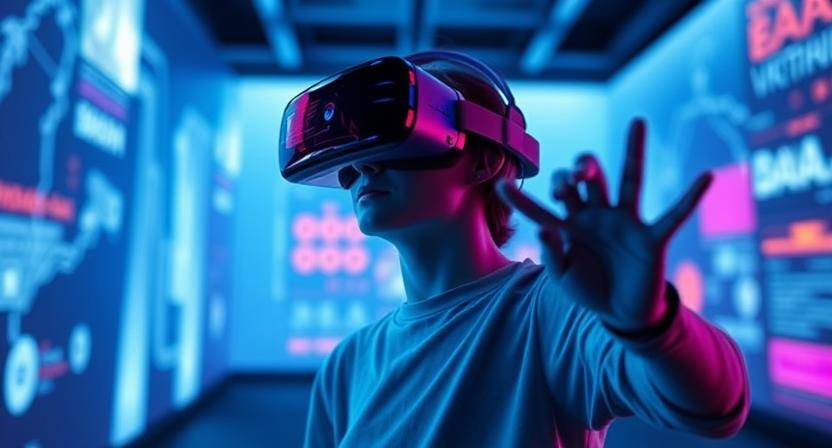Benefits of Incorporating VR Technology in Architectural Design

Virtual Reality (VR) technology offers architects a unique tool to immerse clients and stakeholders into their designs in a way that traditional 2D drawings or 3D models cannot achieve. By allowing users to experience spaces in a realistic and interactive manner, VR enhances communication and understanding among all parties involved in the architectural design process. This firsthand experience helps clients visualize the final outcome more accurately, leading to better decision-making and ultimately a higher level of satisfaction with the end result.
Moreover, incorporating VR technology in architectural design can streamline the design process by identifying potential issues or conflicts early on. Architects can use VR to explore different design options, test lighting and acoustics, and assess the overall functionality of a space before actual construction begins. This not only saves time and resources but also allows for more innovative and efficient design solutions to be developed.
The Evolution of VR in the Architecture Industry

Virtual Reality (VR) has revolutionized the architecture industry by providing designers with powerful tools to visualize spatial designs in a more immersive and interactive manner. Architects can now explore their creations in a three-dimensional virtual environment, allowing for a more comprehensive understanding of scale, proportion, and spatial relationships. This evolution in technology has significantly enhanced the design process, enabling architects to experiment with various design concepts and make informed decisions before the actual construction phase.
Furthermore, the adoption of VR in architecture has facilitated better collaboration among project stakeholders, including architects, clients, engineers, and contractors. With virtual reality technology, all parties involved can virtually walk through the building, providing valuable feedback and insights at an early stage of the design process. This level of engagement and communication has led to more efficient decision-making, reduced errors, and ultimately, improved project outcomes.
Challenges Faced When Implementing VR in Architecture

One of the key challenges faced when implementing VR in architecture is the initial investment required for the technology. High-quality VR equipment and software can be costly, making it difficult for smaller architectural firms to adopt this technology. Additionally, the training and upskilling of staff to effectively use VR tools can be time-consuming and may require additional resources.
Another challenge is the potential for VR technology to isolate users from real-world interactions. This can be a concern when it comes to collaborative design efforts, as architects may rely too heavily on virtual environments without considering the input of their team members. Finding a balance between utilizing VR for its immersive capabilities and maintaining effective communication and teamwork is essential for successful implementation in architectural projects.
Exploring the Role of VR in Enhancing Client Communication

Client communication is a critical aspect of successful architectural projects. VR technology has revolutionized this process by allowing clients to immerse themselves in virtual environments and experience the proposed designs firsthand. This enhanced level of engagement helps bridge the gap between clients and architects, enabling clearer communication and a deeper understanding of design concepts.
By using VR for client communication, architects can showcase their vision in a more interactive and engaging manner. Clients can explore different design options, visualize spatial layouts, and provide real-time feedback, leading to more informed design decisions. This direct involvement in the design process empowers clients to feel a sense of ownership over the project and promotes a collaborative approach to architectural development.
How VR Can Improve the Design Process in Architecture

Virtual Reality (VR) technology has significantly transformed the design process in architecture by providing a platform for architects to immerse themselves in a virtual environment where they can visualize and manipulate their designs in real-time. This level of interactivity allows architects to gain a deeper understanding of spatial relationships, scale, and aesthetics, leading to more informed design decisions. VR enables architects to walk through their creations, experiencing them from different angles and perspectives, enhancing the overall design quality and reducing the likelihood of costly errors during the construction phase.
Furthermore, VR in architecture facilitates better collaboration among project stakeholders by enabling them to virtually gather in the same space regardless of their physical location. This real-time collaboration feature streamlines communication and decision-making processes, ensuring that all team members are on the same page. By allowing clients, architects, engineers, and other professionals to interact with the design simultaneously, VR promotes a more efficient workflow, minimizes misunderstandings, and fosters a sense of shared vision for the project.
The Impact of VR on Collaborative Design Efforts

One of the key advantages of incorporating virtual reality (VR) technology in architectural design is its ability to enhance collaborative efforts among architects, designers, and clients. By immersing all stakeholders in a shared virtual environment, VR enables real-time collaboration and communication, breaking down barriers that may exist in traditional design processes. This can lead to more effective brainstorming sessions, idea exchanges, and decision-making processes, ultimately resulting in a more cohesive and innovative design outcome.
Moreover, VR empowers team members to explore design concepts in a three-dimensional space, facilitating a deeper understanding of spatial relationships and design elements. This hands-on approach to design review allows for more comprehensive feedback and input from all parties involved, fostering a collaborative environment where ideas can be refined and optimized collectively. As a result, the iterative design process can be streamlined, leading to more efficient project development and a higher level of design excellence.
Innovative Ways Architects are Using VR Technology

Architects are harnessing the power of VR technology in innovative ways to revolutionize the design process. By immersing themselves and their clients in virtual environments, architects can provide a more interactive and engaging design experience. This technology enables architects to explore different design options, analyze spatial relationships, and visualize the final project in a more realistic manner.
Moreover, VR technology is being used to conduct virtual walkthroughs of architectural designs, allowing clients to experience the space before construction even begins. This immersive experience helps clients better understand the scale, proportions, and overall design concept, leading to more informed decision-making. Additionally, architects can use VR technology to collaborate with clients and stakeholders in real-time, making changes and adjustments on the spot to ensure the final design meets everyone’s needs and expectations.
The Future Potential of VR in Architectural Visualization

The future potential of VR in architectural visualization is vast and promising. As technology continues to advance, VR has the capability to revolutionize how architects and clients interact with design concepts. By immersing users in realistic virtual environments, architects can convey their ideas more effectively and allow clients to experience spaces before they are built. This not only enhances the design process but also helps in avoiding costly revisions later on.
Moreover, the use of VR in architectural visualization can lead to improved decision-making processes and increased stakeholder engagement. With the ability to easily make changes and visualize different design options in real-time, architects can collaborate more efficiently with clients, engineers, and other team members. This fosters a more iterative and interactive design process that ultimately results in better-designed spaces that meet the needs and expectations of all involved parties.
Case Studies Highlighting Successful VR Integration in Architectural Projects

In a notable architectural project, VR technology was seamlessly integrated to showcase a futuristic urban development to clients. The immersive experience allowed stakeholders to walk through digital renderings of the proposed structures, gaining a comprehensive understanding of the design elements and spatial layout. This interactive presentation not only impressed clients but also facilitated constructive feedback and revisions in real-time, leading to a more refined final concept.
Another successful case study involved a collaboration between architects and interior designers using VR to create a luxury residential complex. By immersing themselves in the virtual environment, the design team was able to experiment with different materials, lighting effects, and furniture arrangements with ease. This facilitated a streamlined decision-making process and enabled the team to deliver a high-end project that met the client’s expectations. The utilization of VR not only enhanced the visualization of the design but also promoted greater team synergy and efficiency in project execution.
The Influence of VR on Sustainable Design Practices

Virtual reality (VR) technology has significantly impacted sustainable design practices within the architecture industry. By allowing architects to visualize and experience green building concepts in immersive virtual environments, VR has become a powerful tool in promoting environmentally friendly design solutions. Architects can now simulate and analyze the performance of sustainable elements such as passive solar design, natural ventilation systems, and green materials in virtual reality, leading to more efficient and eco-friendly building designs.
Furthermore, VR has revolutionized the way architects and clients collaborate on sustainable projects. Through VR simulations, clients can better understand the environmental benefits of green design features, enabling them to make informed decisions that align with sustainability goals. By experiencing virtual walkthroughs of sustainable buildings, clients can appreciate the impact of design choices on energy efficiency, carbon footprint, and overall environmental sustainability. This enhanced communication and comprehension ultimately contribute to the successful implementation of sustainable design practices in architectural projects.
Overcoming Resistance to Adopting VR Technology in Architecture

One of the main challenges in incorporating VR technology in architecture is the resistance faced by some professionals in the field. This resistance can stem from a variety of factors, such as unfamiliarity with the technology, concerns about the cost of implementation, or simply a reluctance to change established workflows and processes. However, in order to fully harness the benefits that VR can bring to architectural design, it is important for architects to overcome this resistance and embrace the potential that this technology offers.
A key strategy for overcoming resistance to adopting VR technology in architecture is education and training. By providing architects and other stakeholders with the opportunity to learn about VR technology and experience its capabilities firsthand, misconceptions and doubts can be addressed. Hands-on training sessions, workshops, and demonstrations can help demystify VR and showcase its potential to revolutionize the design process. Additionally, fostering a culture of experimentation and innovation within architectural firms can help create a more receptive environment for the integration of VR technology.
Comparing VR to Traditional Architectural Design Methods

Traditional architectural design methods have long relied on 2D drawings, physical models, and renderings to convey design ideas. While these methods have been effective in the past, they can sometimes fall short in immersing clients and stakeholders in the envisioned space. On the other hand, VR technology offers a more immersive and interactive way to experience architectural designs, allowing users to physically explore and interact with the proposed spaces before they are built. This dynamic experience not only helps clients better understand the design concepts but also enables architects to make real-time adjustments based on user feedback.
Moreover, traditional design methods often involve multiple iterations and revisions before finalizing a design, leading to increased time and costs. In contrast, VR technology allows for quicker design iterations and visualizations, enabling architects to experiment with different design options efficiently. By providing a more iterative design process, VR helps architects refine their designs faster and more accurately, leading to improved outcomes and client satisfaction.
The Role of VR in Creating Interactive Architectural Presentations

Virtual Reality (VR) technology has revolutionized the way architectural presentations are conducted. Architects can now immerse clients in realistic virtual environments, allowing them to experience designs in a more interactive and engaging manner. By integrating VR into architectural presentations, designers can showcase their concepts with a higher level of detail and accuracy, providing clients with a clearer understanding of the final project.
One of the key advantages of using VR for architectural presentations is the ability to make real-time changes and adjustments to designs. Clients can provide immediate feedback on the virtual environment, allowing architects to tweak elements such as lighting, materials, and layouts on the spot. This seamless collaboration between architects and clients fosters a more efficient and iterative design process, ensuring that the final outcome meets the client’s expectations and requirements.
Addressing Privacy and Security Concerns with VR in Architecture

Privacy and security concerns have arisen in the realm of architectural design with the integration of virtual reality (VR) technology. As architects and clients engage in immersive experiences using VR, questions about data protection and confidentiality have become paramount. Issues such as unauthorized access to design plans, intellectual property theft, and potential breaches of sensitive information have sparked a need for robust security measures within VR applications tailored to the architectural industry.
To address these concerns, architects and developers are implementing encryption protocols, user authentication procedures, and secure network connections when utilizing VR technology in architectural projects. By prioritizing data security from the initial stages of VR integration, professionals can alleviate fears surrounding privacy breaches and establish a foundation of trust with clients. Additionally, fostering awareness among stakeholders about the importance of safeguarding confidential data in VR environments is crucial for maintaining the integrity and credibility of architectural design processes.
The Integration of VR with Building Information Modeling (BIM) Systems

Building Information Modeling (BIM) systems have revolutionized the way architects and designers plan, construct, and manage building projects. The integration of Virtual Reality (VR) technology with BIM systems presents a significant advancement in the architectural industry, offering a more immersive and interactive experience for all stakeholders involved in the project. By combining the precise digital representations of BIM with the immersive capabilities of VR, architects can now visualize and experience their designs in a more realistic and comprehensive manner.
The seamless integration of VR with BIM systems enhances the collaboration and communication among architects, engineers, clients, and other project stakeholders. Through interactive VR models generated from BIM data, project teams can walkthrough and explore the virtual building environment, allowing for real-time design modifications, identifying potential clashes, and improving decision-making processes. This integration not only streamlines the design and construction phases but also ensures a more efficient and cost-effective project delivery.
Exploring the Use of VR for Architectural Education and Training

Virtual reality (VR) technology has revolutionized the way architecture students are educated and trained. By immersing students in realistic digital environments, VR allows them to visualize and interact with architectural designs in ways never before possible. This hands-on experience helps to bridge the gap between theoretical knowledge and practical application, enhancing students’ understanding of complex design concepts and spatial relationships.
Furthermore, VR provides a unique platform for collaborative learning and design exploration in architectural education. Students can work together in virtual environments to brainstorm ideas, simulate design scenarios, and receive real-time feedback from instructors and peers. This interactive and engaging approach fosters creativity, problem-solving skills, and teamwork among students, preparing them for the dynamic and collaborative nature of the architectural profession.
The Economic Benefits of Using VR in Architecture

Virtual reality (VR) technology has significantly impacted the architecture industry by streamlining the design process and reducing costs associated with traditional methods. By using VR, architects can create immersive 3D models of their designs, allowing clients to visualize the final product more accurately. This enhanced visualization reduces the need for costly revisions and alterations during the construction phase, ultimately saving time and money for both architects and clients.
Furthermore, the use of VR in architecture has opened up new opportunities for remote collaboration and communication. Architects can now easily share their designs with clients, contractors, and other stakeholders in real-time, regardless of their physical location. This level of accessibility and efficiency not only improves project coordination but also minimizes travel expenses and time spent on in-person meetings. As a result, incorporating VR technology in architecture proves to be a cost-effective solution with long-term economic benefits.
Analyzing the Psychological Impact of VR on Architecture Users

Virtual reality (VR) technology has the potential to significantly impact users on a psychological level within the realm of architecture. By immersing individuals in virtual environments that simulate architectural spaces, VR can evoke strong emotional responses and influence perceptions. Studies have shown that experiencing architectural designs through VR can enhance feelings of presence and engagement, leading to a more profound connection with the built environment.
Additionally, the interactive nature of VR allows users to explore architectural spaces in a way that traditional methods cannot replicate. This hands-on approach can foster a sense of empowerment and control, as users are able to navigate through virtual buildings, manipulate elements, and experience different design options in real time. As a result, VR can instill a sense of agency and involvement in the architectural design process, ultimately shaping users’ cognitive and emotional responses to the spaces they interact with.
Trends in VR Hardware and Software for Architectural Applications

Virtual reality (VR) technology continues to advance at a rapid pace, with hardware and software developers constantly innovating to enhance the architectural applications of VR. In terms of hardware, there is a trend towards more lightweight and comfortable VR headsets that offer higher resolution displays and improved tracking capabilities. Additionally, hand-held controllers are becoming more intuitive and responsive, allowing architects to interact with their designs in more natural and intuitive ways.
On the software front, there is a growing emphasis on creating user-friendly interfaces that make it easier for architects to manipulate and visualize their designs in VR. Software developers are also focusing on incorporating real-time rendering techniques that allow for more immersive and realistic virtual environments. Furthermore, there is a push towards greater compatibility and integration with other design software and tools, such as Building Information Modeling (BIM) systems, to streamline the design process and enhance collaboration among project stakeholders.
The Ethical Considerations of Using VR in Architectural Design

When it comes to incorporating VR technology in architectural design, ethical considerations play a crucial role in ensuring responsible and respectful practices. One key ethical concern is the potential manipulation of virtual spaces to deceive clients or stakeholders regarding the final design outcome. Architects must uphold transparency and integrity in using VR as a tool for visualization, avoiding misleading representations that may compromise the trust and expectations of those involved in the project.
Another important ethical consideration in utilizing VR in architecture is the protection of intellectual property rights. As virtual models and designs become increasingly sophisticated and detailed, architects must be vigilant in safeguarding their work from unauthorized use or replication. Implementing secure data management practices and establishing clear ownership of VR-generated content are essential measures to prevent intellectual property infringements within the architectural industry.




